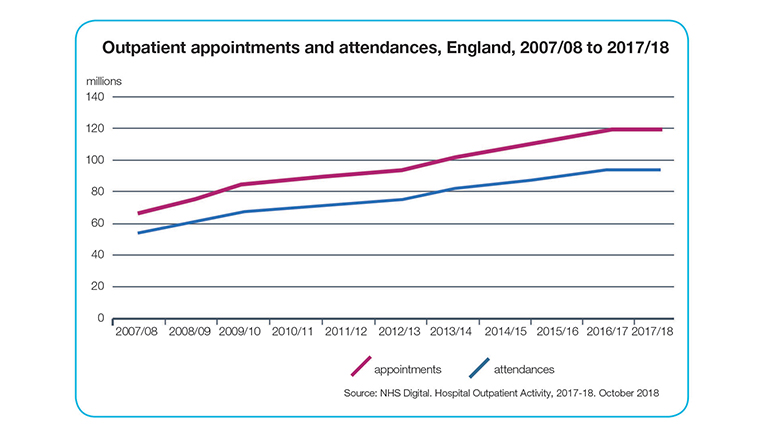NHS in numbers: outpatients
The latest figures from NHS Digital show that there were 96.4 million outpatient attendances in 2018/19 – representing 78% of all appointments made. Some 70% of the non-attendances were due to cancellations by either the hospital or patient, while 30% were simple no-shows.
There has been a 60% increase in attendances (and a 65% increase in appointments) since 2008/09. Over the same time period hospital cancellations have increased by 150% and patient cancellations by 124%.
Modernising outpatients is not about one new model. Virtual consultations will undoubtedly play a part. But there are ways in which services can be reworked. Examples already exist of consultants holding or supporting GPs in outreach clinics. Other areas have had success with direct referrals of potential orthopaedic patients to physiotherapy, making better use of consultant time. And there are moves to give patients a bigger part in deciding if they need a follow-up appointment – perhaps based on the use of patient-reported outcome measures.
Trusts have been encouraged to ensure that follow-up appointments are used only where necessary and this has been underpinned by the tariff payment system. There are specific tariff prices for consultant-led outpatient appointments, with different rates for first and follow-up appointments based on average costs submitted by trusts as part of the reference cost exercise.
However, to incentivise a change in delivery of follow-up activity, first attendances are over-reimbursed and follow-ups under-reimbursed. Different levels of frontloading are set for different service areas (defined by treatment function codes) ranging from 0% to 30%. For example, in this year’s national tariff, a consultant-led first attendance in general surgery attracts a payment of £173 compared with a follow up at £72, after a 30% uplift to the first attendance.
In the current year, non-mandatory prices have also been published for non-face-to-face appointments and non-consultant-led appointments – again the aim is to incentivise new delivery models with systems agreeing local prices informed by the published tariffs.
A non-consultant face-to-face first attendance in general surgery has a guide price of £107 – 60% of the consultant-led equivalent – and this drops to a guide price of £41 if the appointment is non-face-to-face.
Not all areas continue to use individual tariff prices for outpatient payments, although activity and price may be used to inform block contract values.
Outpatient attendances can be usefully broken down further by looking at NHS reference costs. The schedule for 2017/18 – the most up-to-date figures available identify 75 million outpatient attendances and 13 million outpatient procedures – giving 88 million in total. The difference between this and the 94 million attendances highlighted in the NHS Digital figures is due to activity undertaken n the independent sector, according to NHS Digital.
Excluding outpatient procedures, physiotherapy saw the highest number of outpatient attendances at 7.3 million, followed by trauma and orthopaedics at 5.9 million and ophthalmology at 4.7m.
According to reference costs, 70% of the 75 million attendances in 2017/18 were consultant-led, compared to 75% of 67 million attendances in 2010/11, suggesting there has been some small change in involving the wider healthcare team in outpatients delivery.

Related content
The Institute’s annual costing conference provides the NHS with the latest developments and guidance in NHS costing.
The value masterclass shares examples of organisations and systems that have pursued a value-driven approach and the results they have achieved.